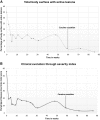A Case of Acute Pemphigus Vulgaris Relapses Associated with Cocaine Use and Review of the Literature
- PMID: 30415373
- PMCID: PMC6261113
- DOI: 10.1007/s13555-018-0271-0
A Case of Acute Pemphigus Vulgaris Relapses Associated with Cocaine Use and Review of the Literature
Abstract
Pemphigus is a bullous autoimmune disease that affects the skin and mucous membranes. It is very difficult to establish the etiology and the triggering factors that influence reactivations in pemphigus vulgaris (PV). The case of a 33-year-old male with chronic history of intranasal cocaine consumption is presented in this report. We present the clinical case of the patient, followed for a total of 86 weeks, with ten relapses secondary to probable cocaine use. The patient was admitted to the emergency department after presenting polymorphic dermatosis characterized by blisters, vesicles, and excoriations extending from the oral cavity to the thorax, and to the inguinal and genital regions, affecting approximately 35 % of the body surface area with a score of 56 on the Pemphigus Skin Disorder Index. Skin biopsies were compatible with PV diagnosis. The patient had clinical improvement with a combination of methylprednisolone 500 mg intravenously (IV) and cyclophosphamide 500 mg IV every 15 days, along with prednisone 50 mg orally (PO) q24 h and mycophenolic acid 500 mg PO q6 h. Persistent cocaine use is highly likely to be the factor triggering lesion reactivation and responsible for the torpid evolution. We cannot definitively conclude whether the change from azathioprine to mycophenolic acid after the tenth relapse was the adjuvant medication responsible for the end of the consolidation phase and complete remission on therapy. This case study could potentially serve as a guide for management of patients who continuously persist with cocaine use, leading to a clinical picture refractory to multiple therapeutic schemes.
Keywords: Acantholytic lesion; Cocaine; Corticosteroid therapy; Mycophenolic acid; Pemphigus vulgaris; Relapse.
Conflict of interest statement
The authors (Omar Jiménez-Zarazúa, Andrés Guzmán-Ramírez, Lourdes N. Vélez-Ramírez, Jesús A. López-García, Leticia Casimiro-Guzmán & Jaime D. Mondragón) have nothing to disclose.
Figures





References
Grants and funding
LinkOut - more resources
Full Text Sources

